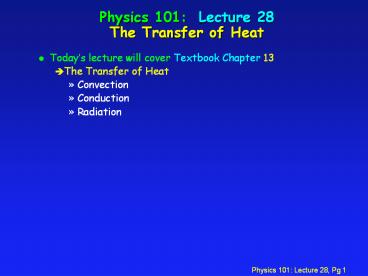Physics 101: Lecture 28 The Transfer of Heat - PowerPoint PPT Presentation
1 / 9
Title:
Physics 101: Lecture 28 The Transfer of Heat
Description:
Which of the following is an example of convective, conductive and ... old house to cool the attic. Physics 101: Lecture 28, Pg 3. Heat Transfer: Convection ... – PowerPoint PPT presentation
Number of Views:35
Avg rating:3.0/5.0
Title: Physics 101: Lecture 28 The Transfer of Heat
1
Physics 101 Lecture 28The Transfer of Heat
- Todays lecture will cover Textbook Chapter 13
- The Transfer of Heat
- Convection
- Conduction
- Radiation
2
Concept Question
- Which of the following is an example of
convective, conductive and radiative heat
transfer? - 1. You stir some hot soup with a silver spoon and
notice that the spoon warms up. - 2. You stand watching a bonfire, but cant get
too close because of the heat. - 3. Its hard for central air-conditioning in an
- old house to cool the attic.
3
Heat Transfer Convection
- Convection heat is transferred by the bulk
movement of a gas or - liquid.
- Example
- Fluid is sitting on a burner is heated from
below. - The fluid right above the flame is getting hot
and thus - expands V increases gt density decrease
- Thus, the hotter fluid experiences a net force
upward (buoyant force) - FB rcold V g gt rhot V g
- Archimedes Principle low density floats on high
density - gt warmer fluid moves upward and is replaced by
cooler fluid -gt - fluid is warmed -gt moves upward -gt and so on
- Cycle continues with net result of circulation of
fluid that carries - heat.
- Practical aspects
- heater ducts on floor
- A/C ducts on ceiling
4
Heat Transfer Conduction
- Conduction Heat is transferred directly trough a
material (bulk motion does not play a role). - Atoms/molecules of hotter materials have more KE
than atoms/molecules of cooler materials. - Gas/fluids high-speed atoms/molecules collide
with low-speed atoms/molecules - energy transferred to lower-speed
atoms/molecules - heat transfers from hot to cold
- Metals electrons can freely move and can
transport - energy
- P rate of heat transfer Q/t J/s
- Q k A (TH-TC)/L
- k thermal conductivity
- Units J/(s m C)
- good thermal conductorshigh k (e.g. metals)
- good thermal insulators low k (e.g. wood)
L Dx
TH Hot
TC Cold
Area A
5
- Example with 2 layers find PQ/t in J/s
- Key Point Continuity (just like fluid flow)
- P1 P2
- k1A(T0-TC)/Dx1 k2A(TH-T0)/Dx2
- solve for T0 temp. at junction
- then solve for P1 or P2
- answers T05.8 C P265 Watts
P1
P2
Inside TH 25C
Outside TC 4C
T0
Dx1 0.019 m A1 35 m2 k1 0.080
J/s-m-C Dx2 0.076 m A2 35 m2 k2 0.030
J/s-m-C
6
Heat Transfer Radiation
- Radiation All things radiate electromagnetic
energy. - Pemit Q/t eA?T4
- e emissivity (between 0 and 1)
- perfect black body has e1
- T is Kelvin temperature
- ? Stefan-Boltzmann constant 5.67 x 10-8 J/(s
m2K4) - No medium required
- All things absorb electromagnetic energy from
surroundings. - Pabsorb eA?T04
- good emitters (e close to 1) are also good
absorbers
7
Heat Transfer Radiation
- All things radiate and absorb electromagnetic
energy. - Pemit Q/t eA?T4
- Pabsorb eA?T04
- Pnet Pemit - Pabsorb eA?(T4 - T04)
- if TgtT0, object cools down if TltT0, object heats
up
8
NASAs Thermal Imaging System
- http//mars.jpl.nasa.gov/
- During day time the sun heats the surface of
Earth or - Mars. At night the materials on the surface emit
this - thermal energy again in form of radiation in the
infrared. - Since different materials emit differently, a
whole - spectrum of infrared radiation is measured which
- is used to identify the material.
9
Concept Question
- One day during the winter, the sun has been
shining all day. Toward sunset a light snow
begins to fall. It collects without melting on a
cement playground, but it melts immediately upon
contact on a black asphalt road adjacent to the
playground. How do you explain this.
Black (asphalt) absorbs electromagnetic waves
(radiation) more readily than white (cement) does
(emissivity is larger). Hence, the black has more
radiation to emit because it has absorbed more.
As a result, it releases more radiation into the
snow, causing the snow to heat up, and melt.































